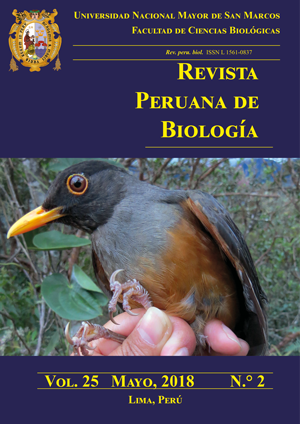High temperature acclimation and termotolerance (TL50) in 6 varieties of Chenopodium quinua*
DOI:
https://doi.org/10.15381/rpb.v25i2.14689Keywords:
Chenopodium quinoa, heat stress, termotolerant, TL50, acclimatization.Abstract
The capacity of acclimatization at high temperature of 6 varieties (Kancolla, Salcedo, Ccoito, Negra collana, Pasancalla and Illpa) of Chenopodium quinoa Willd was studied. Quinoa plants were obtained from seeds, which grew in pots, in a grennhouse, until the phenological stage of 6 true leaves. These were exposed to a heat treatment in a growth chamber with a thermostat at 34/32 °C day/night (D/N) for 3 days and at low light intensity. The non-acclimated plants grew under the same conditions but at temperature of 22/20 °C D/N. The tolerance to high temperature was determined by exposing leaf discs at different times (8, 16, 32 and 64 min) at 50 °C (warm bath), measuring the thermostability of the cell membrane trough the loss of electrolytes with a conductimeter. The degree of thermotolerance was found according to the TL50 (time lethal to 50% of damage). The results showed that the varieties Pasancalla and Illpa presented acclimatization capacity, the most thermotolerant variety was the variety Illpa TL50 = 64 min when it was acclimatized and the most sensitive was Pasancalla TL50 = 8 min when it was not acclimatized. It was also observed that the percentage of cell damage increased as the exposure time to the high temperature was higher.Downloads
Downloads
Published
Issue
Section
License
Copyright (c) 2018 Kimberlayn M. Sanabría A., Herbert O. Lazo R.

This work is licensed under a Creative Commons Attribution-NonCommercial-ShareAlike 4.0 International License.
AUTHORS RETAIN THEIR RIGHTS:
a. Authors retain their trade mark rights and patent, and also on any process or procedure described in the article.
b. Authors retain their right to share, copy, distribute, perform and publicly communicate their article (eg, to place their article in an institutional repository or publish it in a book), with an acknowledgment of its initial publication in the Revista Peruana de Biologia.
c. Authors retain theirs right to make a subsequent publication of their work, to use the article or any part thereof (eg a compilation of his papers, lecture notes, thesis, or a book), always indicating its initial publication in the Revista Peruana de Biologia (the originator of the work, journal, volume, number and date).






